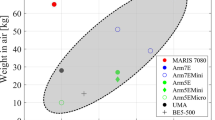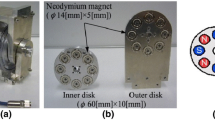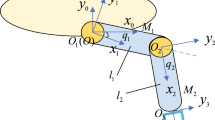Abstract
Disturbance compensation is one of the major issues for underwater robots to hover as a mobile platform and to manipulate an object in an underwater environment. This paper presents a new strategy of disturbance compensation for a mobile dual-arm underwater robot using internal torques derived from redundant parallel mechanism theory. A model of the robot was analyzed by redundant serial and parallel mechanisms at the same time. The joint torque to operate the robot is obtained from a redundant serial mechanism model with null-space projection due to redundancy. The joint torque derived from the redundant parallel kinematic model is calculated to perfectly compensate for disturbances to the mobile platform and is included in the solution of the joint torque based on the serial redundant model. The resultant joint torque can generate force on the end-effector for required tasks and forces for disturbance compensation simultaneously . A simulation shows the performance of this disturbance compensation strategy. The joint torque based on the algorithm generates the desired task force and the disturbance compensation force together, and a little additional joint torque can generate a large internal force effectively due to the characteristics of a redundant parallel mechanism. The proposed method is more effective than compensation methods using thrusting force on the mobile platform.







Similar content being viewed by others
References
Podder TK, Sarkar N (2004) A unified dynamics-based motion planning algorithm for autonomous underwater vehicle-manipulator systems (UVMS). Robotica 22(1):117–128
Cobos-Guzman S, Torres J, Lozano R (2013) Design of an underwater robot manipulator for a telerobotic system. Robotica 31(6):945–953
Fernandez JJ, Prats M, Sanz PJ, Garcia JC, Marin R, Robinson M, Ribas D, Ridao P (2013) Grasping for the seabed: developing a new underwater robot arm for Shallow-Water intervention. IEEE Robot Autom Mag 20(4):121–130
Zheng T, Branson III DT, Kang R, Cianchetti M, Gugliemino E, Follador M, Medrano-Cerda GA, Godage IS, Caldwell DG (2012) Dynamic Continuum arm model for use with underwater robotic manipulators inspired by octopus vulgaris. IEEE international conference on robotics and automation(ICRA), Minnesota, USA, 14–18 May 2012
Yatoh T, Sagara S, Tamura M (2008) Digital type disturbance compensation control of a floating underwater robot with 2 link manipulator. Artif Life Robot 13:377–381
Khatib O (1987) A unified approach for motion and force control of robot manipulators: the operational space formulation. IEEE J Robot Autom RA 2(1):43–53
Hollerbach JM, Suh KC (1987) Redundancy Resolution of Manipulators through Torque Optimization. IEEE J Robot Autom RA 3(4):308–316
Chiaverini S (1997) Singularity-robust task-priority redundancy resolution for real-time kinematic control of robot manipulators. IEEE Trans Robot Autom 13(3):398–410
Park J, Chung W, Youm Y (1999) On dynamical decoupling of kinematically redundant manipulators. IEEE/RSJ international conference on intelligent robots and systems (IROS), Kyongju, Korea, 17–21 Oct 1999
Dietrich A, Ott C, Albu-Schaffer A (2013) Multi-objective compliance control of redundant manipulators: hierarchy, control, and stability. IEEE/RSJ International conference on intelligent robots and systems (IROS), Tokyo, Japan, 3–7 Nov 2013
Sadeghian H, Villani L, Keshmiri M, Siciliano B (2013) Dynamic multi-priority control in redundant robotic systems. Robotica 31(7):1155–1167
Lee S, Kim S, In W, Kim M, Jeong JI, Kim J (2011) Experimental verification of antagonistic stiffness planning for a planar parallel mechanism with 2-DOF force redundancy. Robotica 29(4):547–554
Jin S, Kim J, Seo T (2015) Optimization of a redundantly actuated 5R symmetrical parallel mechanism based on structural stiffness. Robotica 33(9):1973–1983
O’Brien J, Wen J (1999) Redundant actuation for improving kinematic manipulability. IEEE International conference on robotics and automation (ICRA), Michigan, USA, 10–15 May 1999
Kim J, Park FC, Ryu SJ, Kim J, Hwang J, Park C, Iurascu C (2001) Design and analysis of a redundantly actuated parallel mechanism for rapid machining. IEEE Trans Robot Autom 17(4):423–434
Huda S, Takeda Y, Hanagasaki S (2011) Kinematic design of 3-URU pure rotational parallel mechanism to perform precise motion within a large workspace. Meccanica 46:89–100
Gosselin C, Grenier M (2011) On the determination of the force distribution in overconstrained cable-driven parallel mechanisms. Meccanica 46:3–15
Wu J, Chen X, Wang L, Liu X (2014) Dynamic load-carrying capacity of a novel redundantly actuated parallel conveyor. Nonlinear Dyn 78:241–250
Shin HP, Lee D (2015) A new decoupling method for explicit stiffness analysis of kinematically redundant planar parallel kinematic mechanism. Math Probl Eng 2015:957269
Khatib O (1990) Motion/force redundancy of manipulators. In: Japan-USA symposium on flexible automation, Kyoto, Japan, July 1990
Wu J, Wang J, Wang L, Li T (2009) Dynamics and control of a planar 3-DOF parallel manipulator with actuation redundancy. Mech Mach Theory 44:835–849
Wu J, Wang D, Wang L (2015) A control strategy of a two degrees-of-freedom heavy duty parallel manipulator. J Dyn Syst Meas Control 137(6):061007
Fisher WD, Mujtaba MS (1992) Hybrid position/force control: a correct formulation. Int J Robot Res 11(4):299–311
Khatib O (1995) Inertial properties in robotic manipulation: an object-level framework. Int J Robot Res 13(1):19–36
Fossen TI (1994) Guidance and control of ocean vehicles. Wiley, London
Acknowledgments
This research was supported by Basic Science Research Program through the National Research Foundation of Korea (NRF) funded by the Ministry of Education (NRF-2014R1A1A4A01009290).
Author information
Authors and Affiliations
Corresponding authors
Rights and permissions
About this article
Cite this article
Jin, S., Bae, J., Kim, J. et al. Disturbance compensation of a dual-arm underwater robot via redundant parallel mechanism theory. Meccanica 52, 1711–1719 (2017). https://doi.org/10.1007/s11012-016-0505-0
Received:
Accepted:
Published:
Issue Date:
DOI: https://doi.org/10.1007/s11012-016-0505-0




